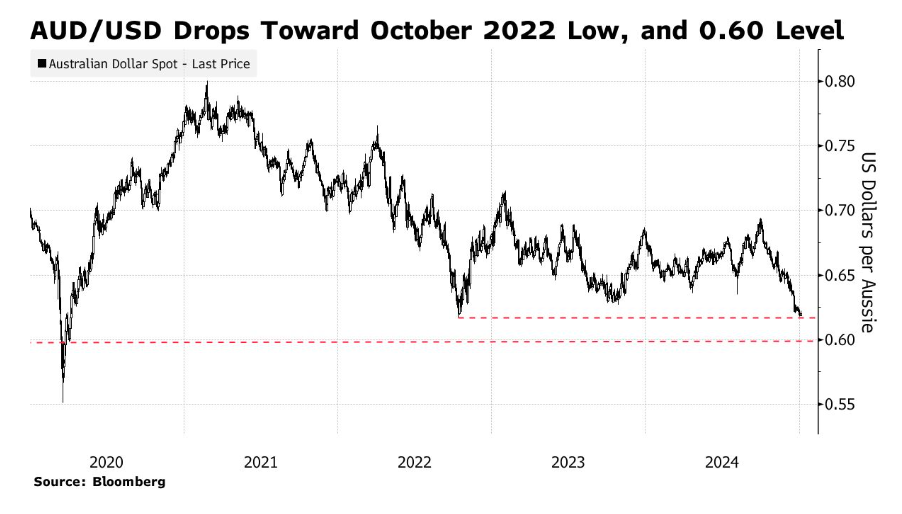 The Australian dollar (AUD) saw its steepest decline in 6 years in 2024, and this downward trend may not be over yet, as the currency heads toward $0,60 in the first quarter of this year. The AUD has been significantly impacted since late September 2024 by increased risk aversion in global financial markets and rising expectations that the Reserve Bank of Australia (RBA) will be forced to cut policy rates again soon. Another downside factor is the looming specter of a trade war between the U.S and China - Australia’s largest trading partner. After sliding 9,2% last year, hitting a low of $0,6179 on December 31, the AUD recovered modestly to close last week at $0,6216. The $0,6170 threshold could face immediate pressure this week if Australia’s November inflation data - due Wednesday -comes in below market expectations, heightening the likelihood of an RBA rate cut at its next policy meeting on February 18. Minutes from the RBA’s December meeting, released over the Christmas period, reinforced the possibility of a rate cut in February. If global equity markets continue to weaken under concerns of a U.S - China trade war, China’s fiscal stimulus proves inadequate, and the RBA is compelled to move swiftly to shore up the economy, AUD/USD could drop to $0,60 in this first quarter.
The Australian dollar (AUD) saw its steepest decline in 6 years in 2024, and this downward trend may not be over yet, as the currency heads toward $0,60 in the first quarter of this year. The AUD has been significantly impacted since late September 2024 by increased risk aversion in global financial markets and rising expectations that the Reserve Bank of Australia (RBA) will be forced to cut policy rates again soon. Another downside factor is the looming specter of a trade war between the U.S and China - Australia’s largest trading partner. After sliding 9,2% last year, hitting a low of $0,6179 on December 31, the AUD recovered modestly to close last week at $0,6216. The $0,6170 threshold could face immediate pressure this week if Australia’s November inflation data - due Wednesday -comes in below market expectations, heightening the likelihood of an RBA rate cut at its next policy meeting on February 18. Minutes from the RBA’s December meeting, released over the Christmas period, reinforced the possibility of a rate cut in February. If global equity markets continue to weaken under concerns of a U.S - China trade war, China’s fiscal stimulus proves inadequate, and the RBA is compelled to move swiftly to shore up the economy, AUD/USD could drop to $0,60 in this first quarter.
Meanwhile, the USD/VND interbank exchange rate slipped by 60 VND last Friday, returning to 25.400 as market participants remained confident in authorities’ measures to stabilize the rate in recent sessions. The exchange rate is forecast to continue its downward trend today, trading around the 25.350 - 25.420 target range.
Asia Commercial Joint Stock Bank assumes no responsibility or liability for any purpose of reference or using the information provided by this newsletter.
Directly contact us to receive market news and consultancy on foreign exchange products and derivatives:
- Financial Markets Division – Email: ktttc@acb.com.vn ; or
- Mr. Khanh Hoang (Financial Markets Senior Analyst) – Email: hoangnk@acb.com.vn
